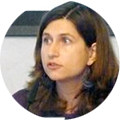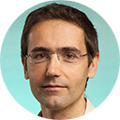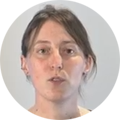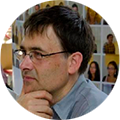 |
Guillaume Agnus
Guillaume Agnus is Associate Professor at Paris-Sud University / CNRS He currently conducts research work at the Center for Nanosciences and Nanotechnologies (C2N) in Paris-Saclay. |
 |
Virginie Albe
Virginie Albe is Professor at Ecole Normale Supérieure Paris Saclay where she currently teaches didactics of sciences and techniques. She is co-responsible for the chapter on societal and toxicological issues (6th week). She currently conducts research work on contemporary changes in academic disciplines in science and technology at the Institute of Social Sciences. |
 |
Mélanie Auffan
Mélanie Auffan is Researcher at CNRS / CEREGE (European Center for Research and Education in Environmental Geosciences, joint research unit with CNRS) - she is a member of LABEX SERENADE (Safe Ecodesign Research and Education applied to NAnomaterial DEvelopment). She currently conducts research works on bio-physico-chemical mechanisms and interactions between nanomaterials and living organisms, using an interdisciplinary and multi-scale approach. |
 |
Laurent Bacri
Laurent Bacri is Associate Professor at Evry University Val d'Essonne / UMR8587 LAMBE. He has studied the dynamics of transport through nanopores for 15 years with the Polymer Materials Interfaces (MPI) team of LAMBE, (Laboratory for Analysis and Modelling in Biology and Environment). The MPI team includes biophysicists, chemists and biologists and is specialized in the transport of polymers and proteins in confined environments, as well as in the folding of proteins at the single molecule level. |
 |
Elizabeth Boer-Duchemin
Elizabeth Boer-Duchemin is Associate Professor at Paris-Sud University where she currently works with the Institute of Molecular Sciences (ISMO). Her research interest involves the development and exploitation of electrical nanosources of photons and plasmons and innovative uses of microscopies with local probe. |
 |
Sarra Bouden
Sarra Bouden is contract researcher at ICMN (Interfaces, Confinement, Materials and Microstructures), which is a joint research unit between CNRS and University of Orléans. Her research interest at ICMN concerns surface modifications, especially by electrochemical functionalization and nanostructuring of different types of substrates for application to environmental sensors. |
 |
Cedric Bouzigues
Cédric Bouzigues is Associate Professor at Ecole Polytechnique where he coordinates the joint chair in cellular biology between Ecole Polytechnique and INSERM. He currently works with the Optics and Biosciences Laboratory (X-CNRS INSERM). His research work is focused on the use of nanoparticles as biomarkers and their application to nanosensors for cellular- and in vivo- imaging of biological signalling pathways. |
 |
Caroline Cannizzo
Caroline Cannizzo is Associate Professor at Evry Val d'Essonne University, where she currently works with the LAMBE laboratory. Her research work is focused on surface functionalization and nanostructuring, especially for applications to electrochemical pollutant sensors. More generally, her research interest includes the synthesis of nanomaterials and their use for sensor applications and eco-design. She is responsible for master courses in Chemistry and Materials Science at the University of Evry. She also teaches Chemistry at Paris-Saclay University. |
 |
Marie Carriere
Marie Carriere is Researcher at CEA Grenoble, where she currently studies the toxicity of nanoparticles on human models (in vitro) and on plant models. She is especially interested in the genotoxic effects of nanoparticles on lung models and in the design of new quantum dots for medical applications in the so-called "safer by design" approach. Her other interest concerns the toxic and pro-oxidative effects of food particles on gastrointestinal models, which are the subjects of her talk in this MOOC. For a more detailed information about her work: https://www.youtube.com/watch?v=N2ilL2Wk0jY |
 |
Hugues Cazin d'Honincthun
Hugues Cazin d'Honincthun received the PhD degree in nanoscience from Paris-Sud University. He is Project Manager with the Department of Educational Innovation (DIP) at Paris-Sud University. He is the educational engineer of this MOOC. He is also in charge of a nanoscience awareness project called "Nano-Ecole-Idf" in the Labex NanoSaclay. He is currently teaching nanoscience in schools. |
 |
Sylvie Chevillard
Sylvie Chevillard is Research Director at CEA and is the head of the Department of Experimental Radiobiology and Technological Innovation (CEA's Fundamental Research Division). This laboratory is currently investigating the effects induced by irradiation on normal tissues and cancers. It also contributes to the analysis of the toxicological risks of nanoparticles and develops innovative technologies for diagnosis and therapy. Sylvie Chevillard is co-author of about 90 publications in international journals. She is President of the Research and Health Section of the French Society of Radioprotection, member of the Board of the French Society of Genetic Toxicology and member of the Doctoral School of Cancerology at Paris-Saclay University, where she is in charge of two teaching modules in the "Cancer Research" Master. |
 |
Francesca Chiodi
Francesca Chiodi is Assistant Professor at Paris-Sud University. She currently works at the Centre for Nanoscience and Nanotechnology of Paris-Saclay University (C2N). |
 |
Magdalèna Couty - Chargée de Projets Scientifiques en Nanosciences à l'ANR
Magdalena is in charge of the research projects in nanoscience at the French Research Agency. She received the Master degree in organic synthesis from Pierre & Marie Curie University in Paris in 2009. She received the PhD degree in Micro-Nanotechnology from Paris-Sud University in 2012. She joined the French Research Agency in 2015 after a two-year postdoctoral experience with the diamond sensor team of CEA-LIST. |
 |
Patrick Couvreur
Patrick Couvreur is Full Professor of Pharmacy at Paris-Sud University, member of the Academie des Sciences and holder of the chair of "Innovations Technologiques" (2010) at the Collège de France. He is a Senior Member of the "Institut Universitaire de France" since 2009. Prof COUVREUR’s contributions in the field of drug delivery, nanomedicine and drug targeting are highly recognized around the world with more than 550 research publications (Google Scholar H-index 124). He founded two start-up companies (Bioalliance entering the stock market in 2005 and Medsqual). His major scientific contribution to the Pharmaceutical Sciences is recognized by numerous international and national awards ("Host Madsen Medal" 2007, Prix Galien 2009, "Médaille de l’Innovation" CNRS 2012, European Inventor Award 2013, Japan Higuchi Award 2015, Doctor Honoris Causa of the University of Ghent etc.). Patrick COUVREUR is appointed as a member of Académie des Sciences, Académie des Technologies, Académie Nationale de Médecine and Académie Nationale de Pharmacie in France, as well as Académie Royale de Médecine (Belgium), Royal Academy of Pharmacy (Spain), National Academy of Medicine (USA) and National Academy of Engineering (USA). Patrick Couvreur was decorated by the "Légion d’Honneur" (France) in 2018. |
 |
Claire Dupas-Haeberlin Claire Dupas- Haeberlin is Professor and Honorary Director of the École Normale Supérieure de Cachan. She is co-contributor to the general information on training, research and industry in nanoscience. She has been the head of the Institute of Fundamental Electronics (IEF - University Paris Sud-Orsay / CNRS - today C2N), where she has contributed to research works on ultra-thin layers and magnetic nanostructures. |
 |
Abdel Illah EL ABED
Abdel Illah El Abed is lecturer at Sorbonne Paris Cité University and Ecole Normale Paris-Saclay. He joined Ecole Normale Paris-Saclay in 2013, where his current research work involves microfluidics, non-linear optics and physicochemical aspects for applications to biology. |
 |
Albert Fert
Albert Fert is Professor Emeritus at Paris-Sud University. He is physicist in the field of electronic and magnetic properties of condensed matter, and currently works with the joint research unit between CNRS, Thales and Paris-Sud University in Palaiseau. Albert Fert was awarded the Nobel Prize in Physics 2007 for the discovery of giant magnetoresistance (GMR), which is an effect observed in multilayers composed of alternating ferromagnetic and non-magnetic conductive layers. GMR has important applications to today’s computer. This discovery was also the starting point of the development of spin electronics, also called spintronics, where both the charge and spin of electrons are exploited in electronic devices and circuits. Albert Fert and his team at the CNRS/Thales research unit have brought important contributions to this new field of physics. His present research interest in nanophysics includes "Skyrmions" and "topological insulators". |
 |
Antoine FILIPE
Antoine Filipe is graduated fom Ecole Polytechnique and doctor in solid-state physics. He presently heads the "Inertial MEMS" unit of the TRONICS Microsystems company. He has about twenty years of experience in the electronic industry. He successively worked with THALES and STMicroelectronics. He founded the electronic design centre SPINTRON in 2003, before joining the TRONICS company which is specialized in nano- and micro-systems. |
 |
Olivier Francais
Olivier Français is Professor at ESIEE Paris where he is member of the Health Energy Environment division. He is currently teaching applied physics, instrumentation and bio-microsystems. His research activity is at the interface between physics, biology and microtechnology. He is specialist in the fields of microfluidics and dielectric characterization of cellular compounds. |
 |
Jean-Jacques Greffet
Jean-Jacques Greffet is Professor at the Institute of Optics Graduate School in Paris-Saclay. He is an alumnus of École Normale Supérieure de Paris-Saclay. He received the PhD degree in solid-state physics from Paris-Sud University in 1988. His current research interest includes light scattering in complex media, super-resolution in near-field optical microscopy, radiative energy transfers at the nanoscale and coherent properties of thermal radiation. More recently, he contributed to light-matter interactions with nano-antennas and quantum optics based on surface plasmons. Jean-Jacques Greffet is senior member of the Institut Universitaire de France. He was award winner of the Servent Prize from Académie des Sciences. |
 |
Anne-Marie Haghiri
Anne-Marie Haghiri is Research Director at CNRS. She is deputy director of the Microsystems & NanoBioFluidics division of the Centre for Nanoscience and Nanotechnology (C2N) in Paris-Saclay. Her research activities concern the development of fluidic platforms for medical diagnosis, including biological separation, biological concentration and ultra-sensitive detection. She currently investigates biosensors based on nanophotonic, plasmonic and electrochemical effects. |
 |
Patrice Hesto
Patrice Hesto is honorary professor at Paris-Sud University and specialist of nanoelectronics. He is co-responsible for the "Tools for nanoscience" chapter and for the general information on training, industry and research in nanoscience. He has been the head of the Microelectronics Pole at Paris-Sud University. He has also been the head of a CNRS Research Group directed to nanoelectronics. |
 |
Hervé Hillaireau
Hervé Hillaireau is Assistant Professor in pharmacotechnie and biopharmacy at Paris-Sud University. He is currently teaching galenic pharmacy. His general research activity within the Elias Fattal’s group of Institut Galien Paris-Sud is directed to cell and particle engineering for therapy. His scientific interest includes the design of targeting nanovectors based on nucleic acids and nucleoside analogues for antiviral and anticancer activity, and the toxicological evaluation of biodegradable nanoparticles. |
 |
Stéphanie Lacour - Directrice de recherche CNRS à l'Institut des Sciences Sociales du Politique, ENS Paris-Saclay
Stéphanie Lacour is Research Director at CNRS and works with the Institut des Sciences Sociales du Politique, which is a joint unit between CNRS, Ecole Normale Paris-Saclay and Paris-Nanterre University. She currently heads the CNRS research group "Standards, Sciences and Technologies" (GDR 3769). Since 2004, her research work has been directed to the regulation of nanoscience and nanotechnology. She has been responsible for the nanoscience and society office of C’Nano Ile-de-France from 2009 to 2016. She is the author of many articles and of three books dedicated to nanotechnologies and nanomaterials. She is a member of different expert groups on these subjects for CNRS, the National Commission of Public Debate, ANSES, ministry of industry and ministry of health. |
 |
Camille Larue
CNRS scientist since 2015, Camille Larue carries out her research at the Laboratory for Functional Ecology and Environment (EcoLab, UMR 5245, CNRS, Toulouse University) in Toulouse. This ecotoxicologist focuses her activities mainly on plant interactions with emerging pollutants such as engineered nanomaterials. She works at the interface with biophysics being a regular user of spectroscopic techniques on synchrotrons to answer her research questions. (www.researchgate.net/profile/Camille_Larue2) |
 |
Louis Laurent
Louis Laurent is Director of Studies and Research at INRS. |
 |
Brice Laurent
Brice Laurent is researcher at the Centre of Sociology and Innovation of Mines ParisTech. His main interest concerns the interrelations between the scientific development and the democratic organisation. He is the author of "Politiques des Nanotechnologies" (Charles Léopold Mayer, 2010) and of "Democratic Experiments" (MIT Press, 2017). |
 |
Bérengère Lebental
Bérengère Lebental is graduated fom Ecole Polytechnique and civil engineer from Ecole Nationale des Ponts, des Eaux et Forêts. She is researcher at the Institut Français des Sciences et Technologies des Transports, de l'Aménagement et des Réseaux (IFSTTAR) and works with the Laboratoire de Physique des Interfaces et des Couches Minces (LPICM), which is a joint research unit between CNRS and Ecole Polytechnique. Her research interest in the "nanosensors for eco-friendly cities" team of LPICM includes nanotechnologies, chemical and mechanical nanosensors and their applications for "sustainable city". Bérengère Lebental actively participates to national and international projects intended to promote nanotechnology applications in the context of the city. |
 |
Bruno Lepioufle
Bruno Le Pioufle is a professor at Ecole Normale Supérieure Paris Saclay. He is specialist in the design of microfluidic devices for biological and medical applications. He currently works with the CNRS SATIE laboratory. He is responsible for the course on Micro / Nanofluidic in chapter 5 of this MOOC. |
 |
Jean-Michel Lourtioz
Jean-Michel Lourtioz is Research Director Emeritus at CNRS and honorary Vice President of Paris-Sud University. He is the coordinator of this MOOC and responsible for the courses in Nanophysics. He also participates in the 1st week of classes. Jean-Michel Lourtioz' research at the Centre for Nanoscience and Nanotechnology (C2N) in Saclay covers a wide variety of scientific topics including lasers, optoelectronics, photonic crystals and nanobiotechnology. |
 |
Dominique Mailly
Dominique Mailly is Research Director at CNRS. He is specialist of the physics of small-scale objects including their low temperature properties and the processes for their fabrication. He has developed original experiments to measure permanent currents in microscopic rings as well as the magnetisation of magnetic nanoparticles. His current research works involve coherence in Quantum Hall effect, electronic transport in graphene and novel two-dimensional systems such as transition metal dichalcogenides of MoS2 type. |
 |
Francelyne Marano
Francelyne Marano is Professor emeritus at Paris-Diderot University where she teaches cellular biology and toxicology. She is a member of the High Council for Public health and vice-president of the expert commission dedicated to "risks for environment". She actively participates in various national plans for health and environment. |
 |
Sylvia Matzen
Sylvia Matzen is Assistant Professor at Paris-Sud University and works with the Centre for Nanoscience and Nanotechnology (C2N). Her research works concerns the integration of epitaxied oxides in micro-electronic devices. Her scientific interest is more specifically directed to ferroelectric and piezoelectric materials in the form of thin films, deposited on oxide substrate and silicon by laser ablation, and structured by different processes in clean room. She currently investigates the piezoelectric and photovoltaic properties of these devices, and adjusts them through a fine control of growth parameters, constraints and interfaces. |
 |
Martine Mayne-L'Hermite
Martine Mayne-L’Hermite is physical chemist at CEA-Saclay and works with the "Nanoscience and Innovation for Materials, Biomedecine and Energy" research unit. Her research activity is in the field of nanoscience and nanotechnology with a more specific interest in carbon nanostructures such as carbon nanotubes and graphene. Her scientific work is directed to synthesis aspects with the objective of better understanding how these naostructures form. She also investigates their properties for applications, especially in the fields of energy, environment and structural materials. |
 |
Alice Mizrahi
Alice Mizrahi is a post-doctoral student at the National Institute of Standards and Technology in United States where she currently works on the design of artificial neurons based on nanodevices. She has previously studied in the Magisterium of fundamental physics at Paris-Sud University. Then, she received the master degree in physics from Cambridge University and the PhD degree in physics from Paris-Sud University. Her PhD studies were directed to the use of spintronic devices with stochastics responses for bio-inspired computing. |
 |
Simona Mura
Simona Mura is currently Associate Professor at Paris-Sud University. In 2008, she received the PhD degree in chemistry and drug technology from University of Cagliari (Italy) and joined Prof. E. Fattal’s team (Galien Institute, Paris-Sud University) as a postdoctoral researcher to perform a study on lung toxicity of biodegradable nanoparticles. She has extensive experience in designing and evaluating drug delivery patterns and solid knowledge in the in vivo study of animal models of cancer development. Her research work is focused on the development and validation of user-friendly in vitro / in vivo models for a quick, efficient use of nanomedicines from laboratory to clinical trials. |
 |
Jimmy Nicolle
Jimmy Nicolle is Associate Professor at the University of Orléans and currently works with the "Interface Confinement Materials and Nanostructures (ICMN)" joint research unit between CNRS and University of Orléans. He first studied physics and materials sciences at University of Lyon. Then he joined the Institut Lumière Matière where his PhD work was directed to the study of graphene properties at very high pressures by Raman spectroscopy. After receiving his PhD, he was recruited as a post-doc engineer by the Institute of Separative Chemistry of Marcoule (ICSM) at CEA, where he developed functionalized nanotube membranes for application to effluent decontamination in the nuclear industry. After two years of post-doctoral position, he joined the ICMN research unit at the Université of Orléans, where he is currently investigating fundamental and applied properties of various carbon nanomaterials such as graphene and carbon nanotubes. |
 |
Serge Palacin
Serge Palacin is Doctor in Organic Chemistry and specialist in surface chemistry and nanoscience. He is responsible for the course on self-assembly, which is part of the "Tools for nanoscience" chapter. He is director of UMR CEA-CNRS NIMBE and coordinator of LabEx NanoSaclay. |
 |
Myriam Pannetier-Lecoeur
Myriam Pannetier-Lecoeur is a condensed-matter Physicist working at CEA-Saclay. Her scientific interest concerns fundamental mechanisms of magnetism at the nanoscale. His research work is focused on magnetic sensors based on spin electronics for applications in the field of neuroscience and in the automotive field. |
 |
Damien Querlioz
Damien Querlioz is Researcher at CNRS and works with the Centre for Nanoscience and Nanotechnology (C2N) in Paris-Saclay. He is currently studying how nanoelectronics can be used to design smart, bio-inspired computing systems with low energy consumption. He is especially involved in the development of a "natively intelligent" memory, whose operation is closer to human memory than conventional computer memories. |
 |
Isabelle Sagnes
Isabelle Sagnes is Research Director at CNRS and works with the Centre for Nanoscience and Nanotechnology (C2N) in Paris-Saclay. Her scientific interest involves organometallic vapor phase growth of III-V semiconductor heterostructures for the fabrication of photonic devices such as vertical cavity surface emission lasers, quantum cascade lasers and integrated photonic crystal nanolasers on a silicon platform. In parallel with her research activities, she is in charge of "Nanotechnologies and Photonics" at the Institute of Sciences, Engineering and Systems (INSIS) of CNRS. She coordinates the French RENATECH network of high-end facilities in the field of micro & nanotechnology. |
 |
Iyad Sarhid
Iyad Sarhid is a PhD student at Paris-Sud University. His PhD is in the field of sustainable energy and plasmonic nano-objects for applications to environment and industry. He is also involved in science popularization (participation to events at Palais de la Découverte and to introductory science workshops for the Science Festival). |
 |
Christian Serre
Christian Serre is Research Director at CNRS / ENS - ESPCI and Head of the Porous Materials Institute of Paris . He is responsible for the course on porous solids, which is part of the Nanochemistry chapter. He is specialist of porous materials, mainly organic-inorganic hybrid solids such as Metal Organic Frameworks (MOFs). |
 |
Emilie Scheers
Emilie Scheeers is PhD student at the University of Orleans and currently works with the Interfaces, Confinement, Materials and Nanostructures (ICMN) laboratory. She received the master degree in materials in extreme conditions from the University of Orleans. Her PhD work includes the development of electrochemical sensors for the detection of micropollutants in aqueous media. She is more especially involved in the development of screen-printed carbon electrodes and the physicochemical study of functionalized carbons. |
 |
Clémence Sicard
Clémence Sicard is Assistant Professor at the University of Versailles Saint-Quentin-en Yvelines since 2013. Her scientific interest is in the development of bio-hybrid materials based on porous solids nanoparticles of the Metal-Organic Frameworks (MOFs) type. Her research activities are focused on the synthesis of nanoscale MOF particles, the preparation and shaping of MOF bio-composites including biological entities (enzymes / MOF). |
 |
Olivier Spalla
Olivier Spalla is senior research scientist at CEA-Saclay in the field of nanomaterials since 1991. He currently studies the synthesis mechanisms of nanoparticles, their stabilization and assembly to obtain new materials, which are especially characterized by using high-technology facility available with synchrotrons. Over the last ten years, he has also investigated the interactions of manufactured nanoparticles with the living world and their potential influence on the environment. Since 2013, he is also responsible for the field of nanoscience and nanotechnology at the National Research Agency. |
 |
Odile Stéphan
Odile Stéphan is Physics Professor at Paris-Sud University and Honorary Member of the Institut Universitaire de France. She is currently leading the STEM Electron Microscopy team at the Laboratory of Solid Physics (LPS), a joint research unit between CNRS and Paris-Sud University. Her research work is focused on growth mechanisms and optical/electronic properties of nanostructures and nanomaterials. |
 |
Maria Tchernycheva
Maria Tchernycheva is researcher at CNRS. She is graduated from Ecole Polytechnique. She received the PhD degree in Physics from Paris-Sud University. Maria Tchernycheva is currently working since 2006 with the Center for Nanoscience and Nanotechnology (C2N) in Paris-Saclay. Her research work is focused on the development of new optoelectronic devices based on semiconductor nanomaterials. |
 |
François Treussart
François Treussart is Professor at the Ecole Normale Supérieure in Paris Saclay. His first research work was directed to quantum and photonic physics in Serge Haroche's team at the Kastler Brossel Laboratory in Paris. In 2006, he changed his scientific orientation to work at the interface between quantum nanophysics and Neurosciences. François Treussart is now currently working with the Laboratoire Aimé Cotton, which is a joint research unit between CNRS, Paris-Sud University and Ecole Normale Supérieure Paris Saclay. |
 |
Christine Vautrin-Ul
Christine Vautrin-Ul is professor at the University of Orléans and currently works with the ICMN Laboratory "Interfaces, Confinement, Materials and Nanostructures". She is responsible for the course on carbon nanostructures, which is part of the Nanochemistry chapter. Her research work is focused on material grafting by organic nanofilms and the development of devices dedicated to environmental metrology. |
 |
Nathalie Westbrook
Nathalie Westbrook is Professor at the Institute of Optics Graduate School. She is graduated from Ecole SupOptique. She received the PhD degree from Ecole Normale Supérieure in Paris for a PhD work on laser cooling of atoms. Nathalie Westbrook is currently teaching in various fields of optics. She currently conducts research works in biophotonics at the Charles Fabry laboratory, with a special focus on optical tweezers applied to the study of cell mechanics. |
 |
Chao Yu
Chao Yu works with the Laboratory of Optics and Biosiences. Her research work is focused on the study of membrane receptor dynamics and membrane-cytoskeleton interaction, using nanoparticle labeling and hydrodynamic force application. |




